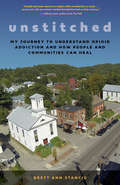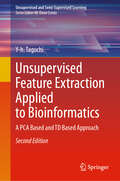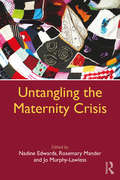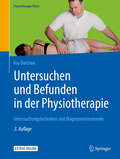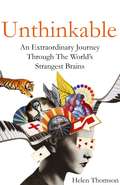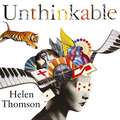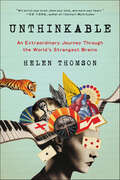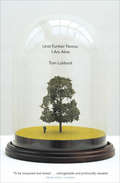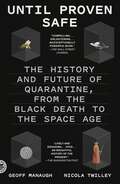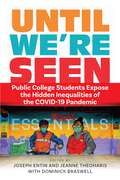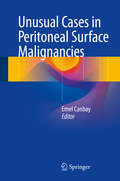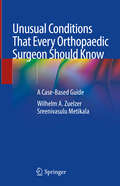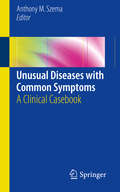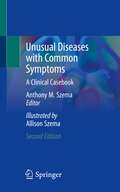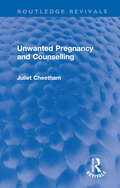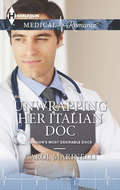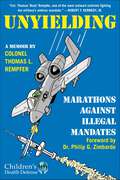- Table View
- List View
Unstitched: My Journey to Understand Opioid Addiction and How People and Communities Can Heal
by Brett Ann StanciuWhat if society looked at addiction without judgement? Unstitched shares the powerful story of one librarian&’s quest to understand the impact of addiction fed by stigma and inevitable secrecy.The opioid epidemic has hit people in communities large and small and across all socio-economic classes. What should each of us know about it, and do about it? Unstitched moves readers from feelings of helplessness and blame into empathy, ultimately helping friends, family, and community members separate the disease of addiction from the person underneath.A stranger, rumored to be a heroin addict, repeatedly breaks into the small-town library Brett Ann Stanciu runs. After she tries to get law enforcement to take meaningful action against him—elementary school children and young parents with babies frequent the place after all—he dies by suicide. When she realizes how little she knows about opioid misuse, she sets out on a mission, seeking insight from others, such as people in recovery, treatment providers, the town police chief, and Vermont's US attorney. Stanciu&’s journey leads to compassionate generosity, renewed faith, and ultimately a measure of personal redemption as she realizes she has a role to play in helping the people of her community stitch themselves back together.
Unsupervised Feature Extraction Applied to Bioinformatics: A PCA Based and TD Based Approach (Unsupervised and Semi-Supervised Learning)
by Y-h. TaguchiThis updated book proposes applications of tensor decomposition to unsupervised feature extraction and feature selection. The author posits that although supervised methods including deep learning have become popular, unsupervised methods have their own advantages. He argues that this is the case because unsupervised methods are easy to learn since tensor decomposition is a conventional linear methodology. This book starts from very basic linear algebra and reaches the cutting edge methodologies applied to difficult situations when there are many features (variables) while only small number of samples are available. The author includes advanced descriptions about tensor decomposition including Tucker decomposition using high order singular value decomposition as well as higher order orthogonal iteration, and train tensor decomposition. The author concludes by showing unsupervised methods and their application to a wide range of topics.
Untangling the Maternity Crisis: Action For Change
by Rosemary Mander Nadine Edwards Jo Murphy-LawlessArguing that contemporary maternity services provide a toxic environment both in which to practise and to give birth, this book looks at how we can change this. Its aim is promoting the best possible experiences of childbearing, and confident, strengthening and loving contexts for new parenthood. Designed to create awareness about the professional and political realities which enmesh maternity care, this inspiring volume features an in-depth and research-oriented analysis of the challenges faced by contemporary maternity services. Recognising the frequently hostile environment in which midwives practise, the contributors go on to explore its impact on women and families, as well as on midwives themselves. They then look at woman-centred and community-based ways of contributing to a much better birthing experience for all. Important and relevant for all those with an interest in improving maternity care, this book is particularly suited to midwives – practising and student, doulas, birth educators and activists, policymakers and health service managers.
Unternehmen Zahnarztpraxis - die Bausteine des Erfolgs
by Nicole Franzen Francesco TafuroNiedergelassene Zahnärzte müssen nicht nur medizinisches Geschick unter Beweis stellen, auch unternehmerische- und Führungs-Qualitäten sind gefragt. Die Autoren beschreiben den Weg zur erfolgreichen Praxis anhand von Themenblöcken: der Zahnarzt als Unternehmer-Persönlichkeit, Betriebswirtschaft, professioneller Praxisauftritt, Teamaufbau und -führung, Organisation und Zeitmanagement, Beratungs- und Aufklärungsgespräche. Fallbeispiele und Praxistipps erleichtern die Analyse der eigenen Situation. Checklisten, Formulare und Textvorlagen auf CD-ROM.
Unternehmen Zahnarztpraxis: Erfolgreich organisieren, delegieren, digitalisieren, skalieren (Erfolgskonzepte Zahnarztpraxis & Management)
by Wolfgang Schmitt Frank ZastrowDieses Buch erzählt von einem Zahnarzt, der die moderne Zahnarztpraxis neu gedacht hat. Begleiten Sie ihn auf seinem Weg und erfahren Sie auf unterhaltsame Weise, wie Sie die Faktoren Zeit, Geld und Leben in einen vernünftigen Einklang bringen. Entscheidend sind kluge, unternehmerische Strategien, um Freiräume zu gewinnen für das, was Ihnen wirklich wichtig ist. Wer vom Getriebenen im Hamsterrad zum Gestalter seines eigenen (Arbeits-)Lebens werden will, kommt an diesem Buch nicht vorbei. Und auch, wer nicht sofort alles anders machen möchte, findet viele nützliche Anregungen. Schaffen Sie die Basis für wirtschaftlichen Erfolg und Lebensqualität zugleich und lernen Sie:Ihre Zahnarztpraxis souverän zu führenDie eigene Expertise weiterzuentwickelnFreiraum für Außerberufliches zu schaffenRegenerationsphasen zu nutzenOrganisierenInterne Prozessoptimierung und klare VerantwortungsbereicheQualitätsmanagement als ChanceModerne maßgeschneiderte Inhouse-KommunikationssystemeDelegierenWas gebe ich wie an wen?Das optimale PraxisteamErfolgsfaktor WertschätzungDigitalisierenPatientengewinnung und -bindung online/offlineWas bieten Sie, was andere nicht haben?Empfehlungs-Marketing und Online-BewertungenSkalierenWelche Praxisform passt zu Ihnen?Einzelpraxis, Gemeinschaftspraxis oder MVZ?Rechtliche und wirtschaftliche Unterschiede
Unterrichten und Präsentieren in Gesundheitsfachberufen
by Jörg SchmalSouverän und anschaulich unterrichten!Dieses Buch richtet sich an Dozenten und Lehrende in Gesundheitsfachberufen und bietet umfangreichen Inhalt für eine gute Gestaltung von Vorträgen, praktischen und theoretischen Unterrichtseinheiten oder Präsentationen. Ein Fachgebiet zu kennen, heißt nicht, es auch ansprechend präsentieren zu können. Der erfahrene Autor hilft Ihnen zu verstehen, was guten Unterrichtet ausmacht und wie Sie Ihre Inhalte erfolgreich weitergeben können. Anhand zahlreicher Praxisbeispiele stellt er didaktische und methodische Grundlagen leicht verständlich und umsetzbar dar. Dabei werden über 60 verschiedene Methoden für abwechslungsreiche Lehr-Lerneinheiten aufgezeigt.So werden Sie sicher in der Darbietung und kreativ in der Wissensvermittlung!
Unterrichten und Präsentieren in Gesundheitsfachberufen: Methodik und Didaktik für Praktiker
by Jörg SchmalZeitgemäß und anschaulich unterrichten! Dieses Buch richtet sich an Dozenten und Lehrende in Gesundheitsfachberufen und bietet umfangreichen Inhalt für eine gute Gestaltung von Vorträgen, praktischen und theoretischen Unterrichtseinheiten oder Präsentationen. Ein Fachgebiet zu kennen, heißt nicht, es auch ansprechend präsentieren zu können. Der erfahrene Autor hilft Ihnen zu verstehen, was guten Unterricht ausmacht und wie Sie Ihre Inhalte erfolgreich weitergeben können. Anhand zahlreicher Praxisbeispiele stellt er didaktische und methodische Grundlagen leicht verständlich und umsetzbar dar. Dabei werden über 60 verschiedene Methoden für abwechslungsreiche Lehr-Lerneinheiten aufgezeigt. So bleibt Ihr Unterricht aktuell und spannend!
Untersuchen und Befunden in der Physiotherapie: Untersuchungstechniken und Diagnoseinstrumente (Physiotherapie Basics)
by Kay BartrowDieses praxisorientierte Lehrbuch vermittelt Schülern und Studierenden der Physiotherapie und Berufseinsteigern das essentielle Handwerkszeug für die physiotherapeutische Untersuchung als Grundlage für eine erfolgversprechende Therapie. Praktisches Vorgehen, Untersuchungs- und Testverfahren, Befundinterpretation, Dokumentation, sowie kompaktes Hintergrundwissen werden strukturiert und verständlich erläutert. Für jeden Untersuchungsschritt wird das Vorgehen anhand ausführlicher Patientenbeispiele und mit zahlreichen Abbildungen veranschaulicht. Plus: Zusatzmaterialien zum Download Neu in der 3. Auflage: typische Fallbeispiele zur Veranschaulichung des Clinical Reasoning Prozesses, erweiterte Hinweise zur Dokumentation von Befundergebnissen, zusätzliche Informationen zum Flaggensystem in der Physiotherapie Für Ausbildung, Studium, Berufsstart und für erfahrene Therapeuten, die ihr Praxiswissen auffrischen wollen.
Untersuchung von linearen und zirkulären Transkripten des TRAM1- und S100A6-Genlokus im Kontext des Harnblasenkarzinoms
by Josephine DuboisDas Harnblasenkarzinom gehört weltweit zu den häufigsten Krebserkrankungen und wird meist erst im Endstadium erkannt. Gegenwärtig verwendete diagnostische Verfahren sind invasiv, zeit- und kostenintensiv und verbunden mit dem Risiko weiterer Komplikationen. Die Entwicklung von nicht-invasiven Tumormarkern für die Diagnose und Nachsorge von Harnblasenkarzinomen ist von großem klinischen Interesse und könnte anhand von RNA-Markern im Patientenurin realisiert werden. Im ersten Schritt wurde daher das Transkriptom vom Urin gesunder Patienten mit dem von Harnblasenkarzinom-Patienten im fortgeschrittenen Tumorstadium verglichen und potentielle Tumormarker identifiziert. Anschließend wurde der Fokus auf die Analyse von linearen und zirkulären RNA-Spezies des TRAM1- und S100A6-Genlokus gelegt und umfassende Studien zur Detektion und Verifizierung der Transkripte durchgeführt. Dabei empfahlen sich insbesondere S100A6-RNAs durch eine solide Nachweisbarkeit im Patientenurin und eine erhöhte Expression mit fortschreitendem Krankheitsstadium als Tumormarker für das Harnblasenkarzinom. Zirkuläre RNAs standen aufgrund ihrer vermuteten erhöhten Stabilität in Körperflüssigkeiten und der bereits bekannten Tumor-biologischen Funktionen ebenfalls im Mittelpunkt der Untersuchungen. Ein besseres Verständnis der vielfältigen Funktionen von zirkulären Transkripten könnte zudem die Entwicklung von therapeutischen Strategien zur Behandlung von Blasentumoren vorantreiben.
Unthinkable: An Extraordinary Journey Through the World's Strangest Brains
by Helen Thomson'Wonderfully clear, fluent and eye-opening' THE TIMES'A stirring scientific journey, a celebration of human diversity and a call to rethink the "unthinkable"' NATURE'An utterly fascinating romp around the nether regions of the human mind' BIG ISSUEIMAGINE . . . getting lost in a one-room flat; seeing auras; never forgetting a moment; a permanent orchestra in your head; turning into a tiger; life as an out-of-body experience; feeling other people's pain; being convinced you are dead; becoming a different person overnight.Our brains are far stranger than we think. We take it for granted that we can remember, feel emotion, navigate, empathise and understand the world around us, but how would our lives change if these abilities were dramatically enhanced - or disappeared overnight? Award-winning science writer Helen Thomson has spent years travelling the world tracking down incredibly rare brain disorders. In Unthinkable she tells the stories of nine extraordinary people. From the man who thinks he's a tiger to the doctor who feels the pain of others just by looking at them, their experiences illustrate how the brain can shape our lives in unexpected and, in some cases, brilliant and alarming ways. Delving into the rich histories of these conditions, exploring the very latest research and cutting-edge medical techniques, Thomson explains the workings of our consciousness, our emotions, our creativity and even the mechanisms that allow us to understand our own existence. Story by remarkable story, Unthinkable takes us on an unforgettable journey through the human brain. Discover how to forge memories that never disappear, how to grow an alien limb and how to make better decisions. Learn how to hallucinate and how to make yourself happier in a split second. Find out how to avoid getting lost, how to see more of your reality, even how exactly you can confirm you are alive. Think the unthinkable.
Unthinkable: An Extraordinary Journey Through the World's Strangest Brains
by Helen ThomsonHow the mind works -- everything from memory to emotion, navigation to creativity -- explained in nine extraordinary human stories.IMAGINE . . . getting lost in a one-room flat; seeing auras; never forgetting a moment; a permanent orchestra in your head; turning into a tiger; life as an out-of-body experience; feeling other people's pain; being convinced you are dead; becoming a different person overnight.Our brains are far stranger than we think. We take it for granted that we can remember, feel emotion, navigate, empathise and understand the world around us, but how would our lives change if these abilities were dramatically enhanced - or disappeared overnight? Award-winning science writer Helen Thomson has spent years travelling the world tracking down incredibly rare brain disorders. In Unthinkable she tells the stories of nine extraordinary people. From the man who thinks he's a tiger to the doctor who feels the pain of others just by looking at them, their experiences illustrate how the brain can shape our lives in unexpected and, in some cases, brilliant and alarming ways. Delving into the rich histories of these conditions, exploring the very latest research and cutting-edge medical techniques, Thomson explains the workings of our consciousness, our emotions, our creativity and even the mechanisms that allow us to understand our own existence. Story by remarkable story, Unthinkable takes us on an unforgettable journey through the human brain. Discover how to forge memories that never disappear, how to grow an alien limb and how to make better decisions. Learn how to hallucinate and how to make yourself happier in a split second. Find out how to avoid getting lost, how to see more of your reality, even how exactly you can confirm you are alive. Think the unthinkable.(P)2018 John Murray Press
Unthinkable: An Extraordinary Journey Through the World's Strangest Brains
by Helen ThomsonIn this Indiebound bestseller, the award-winning science writer unlocks the biggest mysteries of the human brain by examining nine extraordinary cases.Our brains are far stranger than we think. We take it for granted that we can remember, feel emotion, navigate, empathize and understand the world around us, but how would our lives change if these abilities were dramatically enhanced—or disappeared overnight?Helen Thomson has spent years travelling the world, tracking down incredibly rare brain disorders. In Unthinkable she tells the stories of nine extraordinary people she encountered along the way. From the man who thinks he’s a tiger to the doctor who feels the pain of others just by looking at them to a woman who hears music that’s not there, their experiences illustrate how the brain can shape our lives in unexpected and, in some cases, brilliant and alarming ways.Story by remarkable story, Unthinkable takes us on an unforgettable journey through the human brain. Discover how to forge memories that never disappear, how to grow an alien limb and how to make better decisions. Learn how to hallucinate and how to make yourself happier in a split second. Find out how to avoid getting lost, how to see more of your reality, even how exactly you can confirm you are alive. Think the unthinkable.“Helen Thomson’s remarkable book is an astonishing tour of the human brain in all its awesome power and bewildering variation . . . Unthinkable will enrich your brain, blow your mind, and warm your heart.” —Ed Yong, Pulitzer Prize-winning author
Until Further Notice, I Am Alive
by Tom Lubbock&“These are thoughts for us all, sooner or later—and this is a book I'll keep with me, as long as I live.&”—David Sexton, The Scotsman In 2008, art critic Tom Lubbock was diagnosed with a rare brain tumor and told he had only two years to live. Physically fit and healthy, and suffering from few symptoms, he faced his death with the same directness and courage that had marked the rest of his life. Lubbock was renowned for the clarity and unconventionality of his writing, and his characteristic fierce intelligence permeates this extraordinary chronicle. With unflinching honesty and curiosity, he repeatedly turns over the fact of his mortality, as he wrestles with the paradoxical question of how to live, knowing we&’re going to die. Defying the initial diagnosis, Tom survived for three years. He savored his remaining days; engaging with books, art, friends, his wife and their young son, while trying to stay focused on the fact of his impending death. There are medical details—he vividly describes the slow process of losing control over speech as the tumor gradually pressed down on the area of his brain responsible for language—but this is much more than a book about illness; rather, it's a book about a man who remains in thrall to life, as he inches closer to death. &“I hope that if I am ever diagnosed with a terminal illness I will remember to reread Until Further Notice, I Am Alive. It is, in its tough-minded way, truly joyous.&”—Lynn Barber, Sunday Times
Until Proven Safe: The History and Future of Quarantine
by Geoff Manaugh Nicola TwilleyGeoff Manaugh and Nicola Twilley have been researching quarantine since long before the COVID-19 pandemic. With Until Proven Safe, they bring us a book as compelling as it is definitive, not only urgent reading for social-distanced times but also an up-to-the-minute investigation of the interplay of forces–––biological, political, technological––that shape our modern world.Quarantine is our most powerful response to uncertainty: it means waiting to see if something hidden inside us will be revealed. It is also one of our most dangerous, operating through an assumption of guilt. In quarantine, we are considered infectious until proven safe.Until Proven Safe tracks the history and future of quarantine around the globe, chasing the story of emergency isolation through time and space—from the crumbling lazarettos of the Mediterranean, built to contain the Black Death, to an experimental Ebola unit in London, and from the hallways of the CDC to closed-door simulations where pharmaceutical execs and epidemiologists prepare for the outbreak of a novel coronavirus.But the story of quarantine ranges far beyond the history of medical isolation. In Until Proven Safe, the authors tour a nuclear-waste isolation facility beneath the New Mexican desert, see plants stricken with a disease that threatens the world’s wheat supply, and meet NASA’s Planetary Protection Officer, tasked with saving Earth from extraterrestrial infections. They also introduce us to the corporate tech giants hoping to revolutionize quarantine through surveillance and algorithmic prediction.We live in a disorienting historical moment that can feel both unprecedented and inevitable; Until Proven Safe helps us make sense of our new reality through a thrillingly reported, thought-provoking exploration of the meaning of freedom, governance, and mutual responsibility.
Until We're Seen: Public College Students Expose the Hidden Inequalities of the COVID-19 Pandemic (Contemporary Ethnography)
by Joseph Entin and Jeanne Theoharis with Dominick BraswellFirsthand accounts of COVID-19’s devastating effects on working-class communities of colorThe first months of the COVID-19 pandemic were filled with talk of heroes, the frontline workers who kept the country functioning. “And when they write those history books, the heroes of the battle will be the hardworking families of New York,” Governor Andrew Cuomo trumpeted on Labor Day 2020. But what if those heroes, those essential workers and their families, wrote the book themselves?In Until We’re Seen, the heroes write their own stories. Through firsthand accounts by college students at Brooklyn College and California State University Los Angeles, Until We’re Seen chronicles COVID-19’s devastating, disproportionate effects on working-class communities of color, even as the United States has declared the pandemic over and looks away from its impacts.Very few of these students and their families had the luxury of laboring from home; if they were able to keep their jobs, they took subways and buses, and they worked. They drove delivery trucks, worked in private homes, cooked food in restaurants for people to pick up, worked as EMTs, and did construction. They couldn’t escape to second homes; if anything, more people moved in, as families were forced to consolidate to save money. Together, the accounts in this book show that the COVID-19 pandemic did discriminate, following the race and class fissures endemic to US society. But if these are tales of hardship, they are also love stories—of students’ families, biological and chosen—and of the deep resolve, mundane carework, and herculean efforts such love entails.Recounting 2020–2022 through the experiences of predominantly young, working-class immigrants and people of color living in the first two major US COVID-19 epicenters, Until We’re Seen spotlights previously untold stories of the pandemic in New York, Los Angeles, and the nation as a whole.
Untranslated Gene Regions and Other Non-coding Elements: Regulation of Eukaryotic Gene Expression
by Lucy W. Barrett Sue Fletcher Steve D. WiltonThere is now compelling evidence that the complexity of higher organisms correlates with the relative amount of non-coding RNA rather than the number of protein-coding genes. Previously dismissed as "junk DNA", it is the non-coding regions of the genome that are responsible for regulation, facilitating complex temporal and spatial gene expression through the combinatorial effect of numerous mechanisms and interactions working together to fine-tune gene expression. The major regions involved in regulation of a particular gene are the 5' and 3' untranslated regions and introns. In addition, pervasive transcription of complex genomes produces a variety of non-coding transcripts that interact with these regions and contribute to regulation. This book discusses recent insights into the regulatory roles of the untranslated gene regions and non-coding RNAs in the control of complex gene expression, as well as the implications of this in terms of organism complexity and evolution.
Unusual Cases in Peritoneal Surface Malignancies
by Emel CanbayThis book has been designed to provide the full description of the comprehensive management of peritoneal surface malignancies which have originated from different primaries, such as breast cancer, small bowel cancers and imatinib resistant GISTosis and sarcomas and pseudomyxoma. The book provides the most up-to-date information on current approaches such as cytoreductive surgery and hyperthermic intraperitoneal chemotherapy. Given the increasing evidence that the patients who may benefit from this treatment modality avoid potential lethal course of these diseases, the book explores the application of these approaches to a number of types of malignancy. The first chapters explore Benign Multicystic Mesothelioma and Pseudomyxoma Peritonei arising from unusual primaries. Among other explored topics are peritoneal metastases from serous papillary uterine carcinoma, sarcoma and from unusual origins. This book is valuable for surgical oncologists who deal with the management of peritoneal surface malignancies.
Unusual Conditions That Every Orthopaedic Surgeon Should Know: A Case-Based Guide
by Wilhelm A. Zuelzer Sreenivasulu MetikalaThis unique book presents unusual but critical medical conditions that may present to an orthopedic surgeon and that can - if undiagnosed, misdiagnosed or left untreated - result in serious risk to life and limb. Since these conditions are not necessarily common in orthopedic settings, the goal is to promote pattern recognition through the use of a consistent chapter format beginning with illustrative cases for each condition, followed by an appropriate review of the literature, relevant questions, recommended diagnostic and clinical approaches, and bulleted pearls and pitfalls. Conditions presented include necrotizing fasciitis, epidural hematoma, popliteal entrapment syndrome, allergies, coagulations issues, lead toxicity, and much more. Radiographs and intraoperative photographs enhance the case material.
Unusual Diseases with Common Symptoms: A Clinical Casebook
by Anthony M. SzemaThis book presents detailed case reports of unusual diseases with common symptoms, many of which have emerged in the past decade as a result of nature, advances in medical treatment, and increasing recognition of specific underpinnings of human biology and immunology. These rare diseases must now be considered when the mundane diagnoses do not exactly fit the patient's clinical history or treatment fails. Some of these diseases include: eosinophilic esophagitis, blastocystis hominis infection, and paromyces allergic fungal sinusitis. Chapters provide in depth clinical examples of a wide range of diseases affecting multiple organ systems. Each case is structured by: a vignette of the case, background / salient features of the case, diagnosis, treatment, key points, and questions to aid in critical thinking. Unusual Diseases with Common Symptoms: A Clinical Casebook is of great interest to practicing physicians and as a teaching resource for students and residents who will one day encounter conditions more complex than they initially appear.
Unusual Diseases with Common Symptoms: A Clinical Casebook
by Anthony M. SzemaThis book presents detailed case reports of unusual diseases with common symptoms, many of which have emerged in the past decade because of nature, advances in medical treatment, and increasing recognition of specific underpinnings of human biology and immunology. These rare diseases must now be considered when the usually considered diagnoses do not exactly fit the patient’s clinical history or treatment fails. The second edition of this text includes eighteen completely new chapters and cases. Some of the diseases discussed include galactose alpha 1,3 galactose IgE meat allergy, candymaker’s bronchiolitis obliterans from diacetyl, and Balsam of Peru contact allergic reaction from orange soda. Chapters provide in-depth clinical examples of a wide range of diseases affecting multiple organ systems. Each case is structured by a vignette of the case, background/salient features of the case, diagnosis, treatment, key points, and questions/answers to aid in critical thinking.Unusual Diseases with Common Symptoms: A Clinical Casebook (2nd Edition) follows the widely popular first edition, which has over 20,000 downloads worldwide. It is of great interest to practicing health care professionals as well as students and residents who will one day encounter conditions more complex than they initially appear.
Unwanted Pregnancy and Counselling (Routledge Revivals)
by Juliet CheethamThere was a growing concern in the 1970s about the number of unwanted pregnancies and the problems these posed for parents, children and society. Originally published in 1977, this was the first book which, with extensive reference to research material and illustrative case studies, provided a comprehensive analysis of the social and psychological background to unwanted pregnancy and a guide to ways of helping the people concerned. It should still be useful to doctors, nurses, midwives, teachers, social workers, and other professional and lay people whose work brings them into contact with those who are unhappy about a pregnancy. Juliet Cheetham, whose previous contributions to the problem areas of social welfare are widely respected, discusses the different meanings of unwanted pregnancy, and goes on to explore its relationship to the changing position of women; to the role of the contemporary family; to the special problems experienced by natural children and their parents; to existing social and medical provisions. She examines the possibilities, risks and limitations of the various responses to unwanted pregnancy and the services available at the time, and analyses the difficulties men and women experience in using contraception. Juliet Cheetham shows how the beliefs and attitudes of lay and professional people can influence their understanding of, and response to, these highly controversial and emotional subjects. She offers suggestions about the ways in which this influence may be appropriately modified, and the book concludes with a discussion of the special opportunities and problems of counselling those faced with an unwanted pregnancy.
Unwrapped by the Duke
by Amy RuttanAn unexpected inheritance... When Geri Collins learns she's the daughter of a lord her world changes in an instant. Running from a relationship gone wrong, she seizes the opportunity to help her gravely ill father by running his Harley Street clinic. If only she didn't have to deal with the sensual temptation of her new partner-the notorious "Dark Duke"! Thomas Ashwood unnerves her with every burning look and suggestive word. And as Christmas approaches Geri finds herself contemplating the consequences of a kiss under the mistletoe...
Unwrapping Her Italian Doc: Unwrapping Her Italian Doc / Tempted By The Bridesmaid / Italian Doctor, No Strings Attached / Even Film Stars Still Shop (London's Most Desirable Docs #704)
by Carol MarinelliThe ultimate Christmas present! Louise Carter is a midwife on a mission-to have the best Christmas ever! It's been a difficult year, but stealing a kiss under the mistletoe from gorgeous Italian obstetrician Anton Rossi will make sure it ends on a high! Anton is all about control-but around Louise he feels totally powerless! All he wants to do is kiss her smart mouth senseless-with chemistry this hot, who needs mistletoe anyway? And he certainly won't be stopping with just one kiss...
Unwrapping the Neurosurgeon's Heart: The Doctors' Christmas Reunion / Unwrapping The Neurosurgeon's Heart (Harlequin Lp Medical Ser.)
by Charlotte HawkesAt the heart of a playboy……is the man of her dreams.ER doc Anouk Hart wishes she could ignore her traitorous body’s reaction to high-flying neurosurgeon Solomon Gunn. Yet beneath his playboy reputation, Anouk sees flashes of compassion, which are even more dangerous than his charm! Especially when the warmth of Sol’s Christmas spirit starts to make her long to unleash the real Solomon Gunn and keep him by her side forever!“What an interesting, fast-paced, surprising and entertaining read Ms. Hawkes takes readers on with this book where…the dialogue was riveting and…the chemistry between this couple was strong and tangible from the moment they meet….”—Harlequin Junkie on Christmas with Her Bodyguard“Overall, Ms. Hawkes has delivered a really good read in this book where I smiled a lot because of the growing relationship between the hero and heroine…the romance was well worth the wait because of the building sexual tension between the pair….”—Harlequin Junkie on A Surgeon for the Single Mom
Unyielding: Marathons Against Illegal Mandates
by Thomas L. RempferUnyielding tackles a recurring topic of national importance as a history lesson for future generations. Controversial illegal medical mandates impacted military populations for many decades, but it was not until the COVID-era that the American people witnessed similar overreach. Colonel Tom &“Buzz&” Rempfer&’s memoir retraces the anthrax vaccine history since it marked the first time the military was served with court rulings condemning premeditated illegal experimentation on our nation&’s troops. The advent of COVID mandates, imposed on the population in 2021, gave the American people a taste of the mistreatment previously reserved for our nation&’s warriors. Legal protections enacted by the Congress to guard against medical experimentation, meant to ensure safe, effective, and FDA-approved products, were instead adulterated to foist mandates on American society. According to the FBI, the motive for the anthrax letter lab leaks in 2001 was to &“rejuvenate&” the &“failing&” anthrax vaccine. Similarly, the suspected Wuhan lab leak two decades later resulted in a push for COVID injections. The pattern of fear-based bioincidents resulting from reckless biodefense enterprises, and lessons not learned with illegal mandates, paralyzed government and military leaders while wreaking havoc on the trust and health of our troops and the American people. Buzz&’s decades-long analysis of the breakdowns stands as a unique treatise on the failures of leaders to learn lessons from these enduring clashes and to correct the damage. Future generations will sort out the aftermath, but in the meantime, Colonel Rempfer&’s Unyielding effort attempts to ensure that the lessons are not lost.
